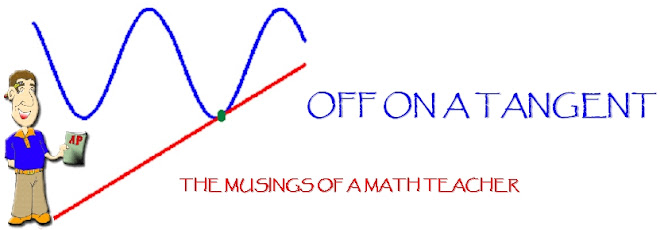 Yesterday I posed a mathematical puzzle in which I challenged you to determine the ages for three children based on some loose, esoteric clues. Due to the overwhelming lack of response, I assuming that either no one read it or I was able to sufficiently stump you.
Yesterday I posed a mathematical puzzle in which I challenged you to determine the ages for three children based on some loose, esoteric clues. Due to the overwhelming lack of response, I assuming that either no one read it or I was able to sufficiently stump you.For those of you who DID give it a go, did you determine that the woman had twins? Did you figure out which one had blue eyes? Do you now know what the census taker ate for breakfast?
Let's explore now how the census taker, after a hearty morning meal of bacon, eggs, and grits, was able to complete his inventory of the house of the enigmatic mother of three.
For the first clue, the woman said that the product of ages of her children equaled 36. If we assume that none of her children are age "zero",as I used to muse about my 6-month-old daughter, and if we also assume that we're talking about integer ages of kiddos, then there are only a small, finite number of possible ages that fit the equation. A careful attempt can yield all eight possibilities. Here they are. Check my work. Make sure they're the same as yours.

Although it would be highly unlikely that the woman would have a pair of one-year-old twins and a another 36 year-old rug rat, but that still leaves seven respectable possibilities. It's obvious why the man had to ask for the second clue. But with the extra hint that the sums of the ages totaled the address of the house across the street, how does that help us? The census take actually got to SEE the number of that house, while we were kept in the dark. Well, it turns out that we don't even need to know the number of the house!! So why have that clue at all, right? To answer that, we'll need to look at what the sums of all the above combinations yield.

Do you notice anything peculiar about the sums? You should see that all but ONE of the sums are unique. The sum of "13" actually appears twice! This means that the house across the street MUST have been house number thirteen. Duhhhhh! Right? Why's that? If it's not obvious to you, I'll explain further. This fact has nothing to do with the numbers of the mathematics of the sums AT ALL. It comes from a clue from the puzzle scenario. Remember that the census taker needed a third clue in order to conclude his detective work. Had the sum been any of the other combinations, he would have had his answer, but because 13 appears twice, he needed further clarification as to which of the remaining two options were the actual ages.
Even though the woman was put out at the man's final request, comparing his annoying unrelentingness to her eldest child, and refused to offer her assistance any more, she unwittingly provided him with all the information he needed.
Do you see it yet?
Her children now had possible ages of 1, 6, and 6 or 2, 2, and 9. Because the woman has an eldest child, we can infer that she has a pair of two-year-old twins and one, eldest child age nine!
A pretty nifty piece of mathematical detective work, huh.
Well, stop the presses. Just like Andrew Wiles's origianl proof of Fermat's Last Theorem was later found to contain a flaw that was overlooked by everyone, so too does my little scenario contain a tiny glitch. My wife immediately pointed out that the ages could be a 1-year-old and a pair of 6-year-old twins, since even twins, apparently, are born ONE AT A TIME, so that even though they are the same "age," there is an OLDER twin and still an ELDEST child.
 D'0h!
D'0h!Andrew Wiles eventually fixed the error in his proof, and now it stands as rock solid. I'm hoping I can reconcile this tiny inconsistency as successfully as he was able to. Perhaps I can go back to the original scenario and somehow cleverly work in the necessary condition that all ages be rounded to the nearest year, or maybe I'll just rewrite it so that the status taker never even offends the woman at all, with her simply telling him, "two, two, and nine. Goodbye."






1 comment:
That's wonderful and it's so easy (now that you explained it).
Happy Friday.
Post a Comment